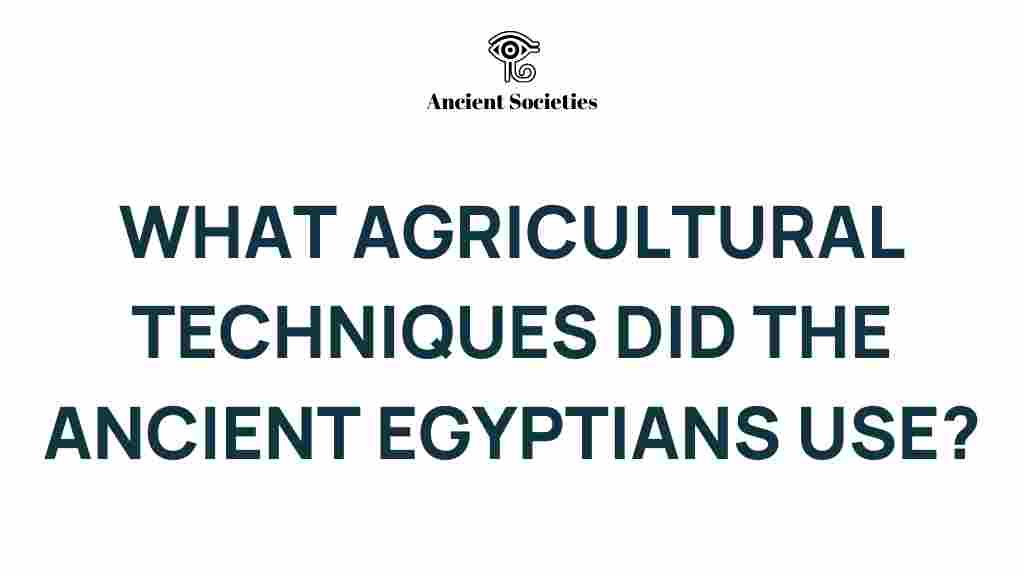Unearthing Ancient Egyptian Agriculture: Secrets of the Nile
Ancient Egypt, known for its monumental architecture and rich history, also boasts a fascinating agricultural legacy. The civilization flourished thanks to the life-giving waters of the Nile, which provided essential resources for farming. This article delves into the techniques, crops, and technologies that characterized ancient Egyptian agriculture, showcasing how this civilization thrived in a challenging environment.
The Importance of the Nile
The Nile River was the backbone of ancient Egyptian agriculture. It was not just a source of water but a critical factor in the civilization’s survival and prosperity. Here are some key aspects of the Nile’s influence:
- Flooding Cycle: The annual flooding of the Nile deposited nutrient-rich silt on the land, making it fertile for agriculture.
- Water Supply: The river provided a consistent water source for irrigation, crucial in an arid climate.
- Transportation: The Nile served as a highway for transporting goods, including agricultural products.
Techniques of Ancient Egyptian Agriculture
Ancient Egyptians developed various agricultural techniques that allowed them to maximize the potential of their land. These techniques were essential for cultivating crops and ensuring food security for their growing population.
Irrigation Systems
Irrigation was a cornerstone of ancient Egyptian agriculture. The Egyptians devised ingenious systems to control the floodwaters of the Nile:
- Shaduf: A hand-operated device used to lift water from the Nile and distribute it to fields.
- Canal Systems: A network of canals was constructed to channel water from the Nile to farmlands.
- Basin Irrigation: Farmers created basins to capture floodwaters, allowing them to irrigate their crops during dry periods.
Crop Rotation and Fertility Management
The ancient Egyptians understood the importance of maintaining soil fertility. They practiced crop rotation, alternating between different crops to prevent soil depletion. Additionally, they used organic materials, such as animal manure, to enrich the soil.
Crops Grown in Ancient Egypt
The ancient Egyptian diet was diverse, largely due to the variety of crops cultivated along the Nile. Some of the primary crops included:
- Wheat: A staple grain, wheat was used to make bread, a fundamental part of the Egyptian diet.
- Barley: Grown mainly for beer production, barley was another essential crop.
- Flax: Cultivated for its fibers, flax was used to make linen, a significant textile in ancient Egypt.
- Legumes: Beans and lentils provided essential proteins in the Egyptian diet.
- Fruits and Vegetables: Onions, garlic, leeks, and various fruits like figs and dates were commonly grown.
The Role of Technology in Ancient Egyptian Agriculture
Technology played a pivotal role in enhancing agricultural productivity in ancient Egypt. The Egyptians were innovative and resourceful, using available resources to improve their farming methods.
Plowing Techniques
Ancient Egyptians utilized wooden plows, often drawn by oxen, to till the soil. This method allowed for deeper penetration into the earth, promoting better crop yields.
Storage and Preservation
To manage surplus crops and prevent spoilage, ancient Egyptians developed sophisticated storage techniques. Granaries made of mudbrick were built to store grains, keeping them safe from pests and moisture.
Understanding the History of Ancient Egyptian Agriculture
The history of ancient Egyptian agriculture dates back to around 5000 BCE, with the development of farming practices along the Nile. Over centuries, the techniques evolved, influenced by various factors:
- Dynastic Changes: Different dynasties brought innovations and changes in agricultural practices.
- Religious Influence: Agriculture was often intertwined with religious practices, with gods associated with fertility and harvest.
- Trade and Economy: The agricultural surplus enabled trade with neighboring regions, enhancing the economy.
Step-by-Step Process of Ancient Egyptian Farming
The farming process in ancient Egypt was systematic and well-organized. Here’s a step-by-step overview:
1. Preparation of the Land
Farmers would first wait for the Nile to flood, then use the rich silt to prepare the fields. After the waters receded, they plowed the land.
2. Planting
Seeds were typically sown in the wet soil after the floods. Timing was crucial, as planting too late could result in poor yields.
3. Irrigation Management
Farmers used their irrigation systems to ensure that the crops received adequate water throughout the growing season.
4. Harvesting
Once the crops matured, they were harvested using sickles. Timing was again critical to avoid losses from adverse weather or pests.
5. Storage and Distribution
After harvesting, crops were stored in granaries. Surplus crops were traded or distributed, ensuring that the economy flourished.
Troubleshooting Tips for Ancient Farmers
Even with advanced techniques, ancient Egyptian farmers faced challenges. Here are some common issues and their solutions:
- Pest Infestations: To combat pests, farmers would practice crop rotation and use natural repellents.
- Water Scarcity: During dry spells, farmers relied heavily on their irrigation systems to ensure crops received enough water.
- Soil Degradation: Regularly rotating crops and incorporating organic matter helped maintain soil health.
Conclusion
Ancient Egyptian agriculture was a sophisticated and integral part of one of history’s greatest civilizations. The techniques developed along the Nile, from irrigation to crop management, laid the foundation for a thriving society. By understanding these practices, we can appreciate the ingenuity and resilience of the ancient Egyptians in harnessing their environment for agricultural success.
For more insights into agricultural practices and their historical significance, explore this link. To delve deeper into the fascinating history of Ancient Egypt, check out this resource.
This article is in the category Archaeology and created by AncientSocieties Team
